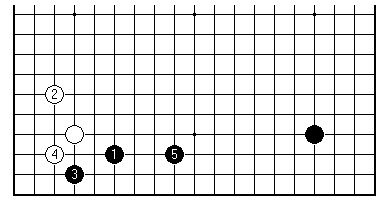

I want to launch this new series of articles on the opening in Go by explaining something about the study of positions on the side. It is quite uncommon to take one side as the explicit unit; usually people discuss full board openings, or the highly-developed theory of corner openings.

Given knowledge of only ten corner openings, several hundred side openings that combine them can be constructed. Initially this might convince anyone that it is a bit futile to aim for knowledge of side openings. There are however some very simple examples, such as this one, that occur frequently in contemporary professional play. Before dismissing their study, one should have a look at the normal tools. It has been said that corner openings sharpen one's Go, because their close study demands understanding of shape and special tactics, as well as judgements comparing territory and influence. What corresponds on the sides?
One has to marshal, not just concrete examples, but a battery of techniques, to discuss sensibly even one side at a time. Firstly there is some rather dogmatic material, which can be divided into the proper handling of extensions, and the priority to be given to plays in the corner versus plays on the side. There is the idea of balance in Go, between territory and influence, third line and fourth line plays, and generally jam today and jam tomorrow. Then there is application of the general strategic theory of Go - frameworks and weak groups, aji and miai, and so on. This is essential for progress anyway, and examples restricted to one side are simplifications (whether in a good or bad sense). Modern Go uses the 4-4 points in the corner intensively, and can hardly be understood at all without talking in these terms. In the example given Black plays very directly for a framework on the lower side; the side is still open to invasion by White, but finding how to think about that depends on developing a feeling for direction of play. Finally there are remarks based on the actual size of the 19x19 board - again these are deeply implicated in the most basic contemporary 4-4 openings.
The fact is that in competent amateur play matters are often effectively settled on the sides, the corners being a matter of standard knowledge, and all-out central fighting avoided because of its genuine difficulty. In restricting to one side, one naturally assumes first that it is the main arena deserving current attention. Of course one ultimately has to look at all four sides, and develop a whole board vision. In the examples that are given it will probably help to imagine the other corners occupied at 4-4 points, as so often in pro play, giving one or two full board openings. Just as with corner openings, there is the problem of understanding the out-turn in the overall context; but it should be less vexed, at least if one learns to question which side is most urgent, in parallel with acquiring actual patterns.
Returning then to the example given, it is one of a number of ways of playing out a side where 4-4 points face off against each other.
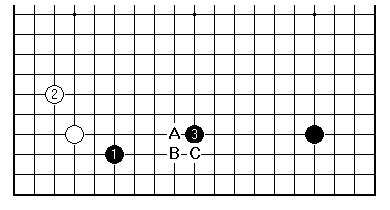
Compared with the family of positions like this one (where 3 might be also at A, B or C), Black has done the maximum possible to settle a group in the left-hand corner. The gap remaining on the side is six lines wide, rather than five.
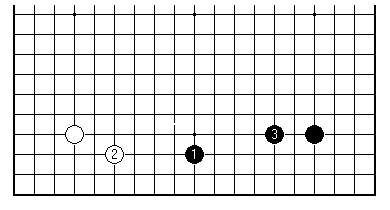
It is certainly possible for Black to play 1 in a different style, not as an approach move in the left corner, but as an extension to 1 here. Then White 2 restricts the scale of the framework possible for Black, and Black 3 is urgent to support Black 1.
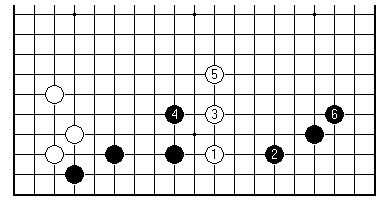
The effect of Black's choice is seen if White invades at 1 here. Black can play at 2 without feeling any concern for the left-hand part of the formation. After 5 White has a weak group still, and Black makes territory in the right corner with a clear conscience.
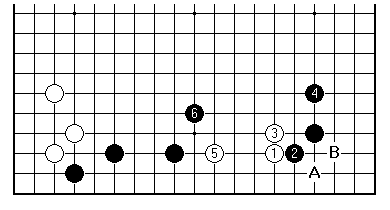
It is more interesting for White to come in with a conventional approach move. If White plays 1 Black should forbid White the slide into the corner at A, by playing 2. With 5 White tries to make a base, but now Black 6 shows how much Black gains from White's relative weakness and the lack of symmetry along this side. It may be that White hopes to gain later by invading at B, but for the present White needs to defend the existing side group. Black has made good use of first play in this part of the board.
Of course, if you make a framework, you hope your opponent can't gain an advantage by invading it at once. If that isn't true - well, it sounds like the case that your opponent has some existing strength, and by invading can destroy potential territory at the same time as giving you problems with your own weak group(s). Then you should play more solidly. However the normal situation is that frameworks aren't immediately invaded. There is some middlegame theory about playing invasions "just in time", one play ahead of an ideal consolidation.
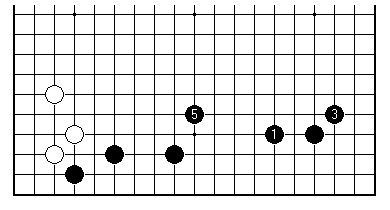
Let's look at ways in which this framework may expand towards secure territory. This is one relatively conservative plan. Black seems to have about 40 more points than White here, with four more stones.
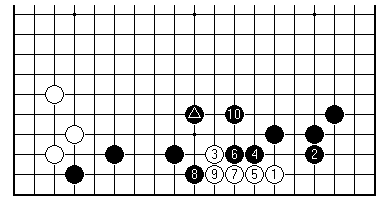
It is probably possible to debate endlessly the security of the territory. When White invades this way Black has the luxury of good shape after 10, the marked stone having ended up on a good point.
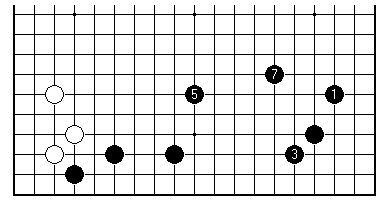
In this case Black may take about 55 more points than White, with five more stones.
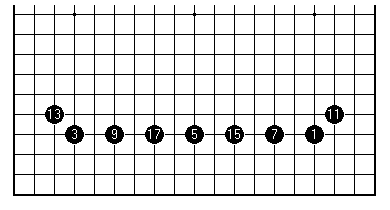
For comparison, this is a famous kind of framework, that has been turned into a 63 point side, at a cost of nine plays. Now 15 and 17 here seem to be lesser plays than those that came before, and Black also deserves something for outside influence. It is rather foolish anyway to talk of frameworks as secure territory, until you know more about the direction of middlegame fighting, which may suddenly cause an unsuccessful sequence to blossom into a serious invasion.
But surely there is enough to the counting to show the trend. Frameworks that potentially add 10 or 11 points per extra stone are ambitious. Of course the opponent will intervene at some point: framework play on a sufficiently grand scale forces the opponent's hand, and one will see attempted invasions or reduction plays.
Perhaps there is a helpful analogy with Monopoly. There investing in railway stations offers a limited synergy and a strict ceiling on upgrading your assets; the real money is in laborious property development, houses and hotels offering increasing returns. In something of the same way, framework play goes beyond strictly cumulative construction of territory. Most frameworks, and just about all of those that are easy to handle, are based on initial claims along the sides of the board.
In conclusion the example under discussion seems to be a sound enough start to a framework. The group Black builds on the left is strong enough to take care of itself, as a kind of sheet anchor; and though it is rooted firmly on the third line, the framework as a whole can eventually expand into the centre.
[01]
[02]
[03]
[04]
[05]
[06]
[07]
[08]
[09]
[10]
[11]
[12]
[13]
[14]
[15]
[16]
[17]
[18]
[19]
[20]
[21]
[22]
[23]
[24]
[25]
[26]
First published 5 October 2000 as On Your Side on MindZine,
Go Learning
© Charles Matthews 2000.